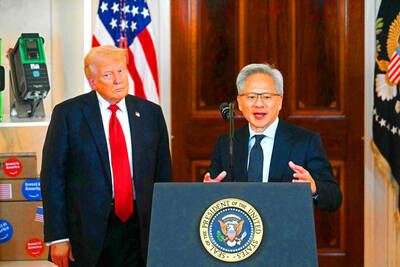Wafer probing service provider Chunghwa Precision Test Technology Co (CHPT, 中華精測) expects revenue to grow quarterly for the remainder of the year, as it is well-positioned to benefit from the robust demand for processors used in 5G smartphones and high-performance computing devices such as data centers.
The growth momentum was disrupted last quarter as CHPT’s engineers were prohibited from visiting customers’ factories for product qualification after the government raised the COVID-19 alert in May to level 3 to curb infections, the company said yesterday.
As the government eased some restrictions this week, the company expects to regain momentum from next month, as 5G-related infrastructure deployment, electric vehicles and remote work continue to stimulate demand.

Photo: CNA
“The COVID-19 outbreak has upended the normal seasonal patterns this year,” CHPT president Scott Huang (黃水可) told an online investors’ conference in Taipei. “The second and third quarters used to be the best quarters for the company. This year, each quarter would be higher than the previous one, probably making the fourth quarter the best quarter of the year.”
For the full year, revenue is expected to surpass last year’s NT$4.23 billion (US$151 million), thanks to growing demand for its wafer probe card business, Huang said.
The outlook for next year is positive, he added.
The company’s top client is expected to contribute more than 30 percent to its total revenue this year, filling the void left by two of its major customers last year, he said.
The wafer probe card business accounted for 35 percent of the company’s overall revenue last quarter, down from 41 percent the previous quarter due to COVID-19 restrictions, the Pingjhen District (平鎮), Taoyuan-based company said.
Net profit contracted 7.3 percent to NT$216 million last quarter from NT$233 million a year earlier, but rose 28.57 percent from NT$168 million in the previous quarter, it said.
Earnings per share dropped to NT$6.16, compared with NT$7.11 a year earlier and NT$5.11 in the first quarter.
Net profit in the first half of the year was NT$384 million, it said.
Gross margin fell to 53.8 percent last quarter from 54.1 percent in the first quarter and 54.1 percent in the second quarter last year.

Taiwan Semiconductor Manufacturing Co (TSMC, 台積電) last week recorded an increase in the number of shareholders to the highest in almost eight months, despite its share price falling 3.38 percent from the previous week, Taiwan Stock Exchange data released on Saturday showed. As of Friday, TSMC had 1.88 million shareholders, the most since the week of April 25 and an increase of 31,870 from the previous week, the data showed. The number of shareholders jumped despite a drop of NT$50 (US$1.59), or 3.38 percent, in TSMC’s share price from a week earlier to NT$1,430, as investors took profits from their earlier gains

AI TALENT: No financial details were released about the deal, in which top Groq executives, including its CEO, would join Nvidia to help advance the technology Nvidia Corp has agreed to a licensing deal with artificial intelligence (AI) start-up Groq, furthering its investments in companies connected to the AI boom and gaining the right to add a new type of technology to its products. The world’s largest publicly traded company has paid for the right to use Groq’s technology and is to integrate its chip design into future products. Some of the start-up’s executives are leaving to join Nvidia to help with that effort, the companies said. Groq would continue as an independent company with a new chief executive, it said on Wednesday in a post on its Web

CHINA RIVAL: The chips are positioned to compete with Nvidia’s Hopper and Blackwell products and would enable clusters connecting more than 100,000 chips Moore Threads Technology Co (摩爾線程) introduced a new generation of chips aimed at reducing artificial intelligence (AI) developers’ dependence on Nvidia Corp’s hardware, just weeks after pulling off one of the most successful Chinese initial public offerings (IPOs) in years. “These products will significantly enhance world-class computing speed and capabilities that all developers aspire to,” Moore Threads CEO Zhang Jianzhong (張建中), a former Nvidia executive, said on Saturday at a company event in Beijing. “We hope they can meet the needs of more developers in China so that you no longer need to wait for advanced foreign products.” Chinese chipmakers are in

POLICY REVERSAL: The decision to allow sales of Nvidia’s H200 chips to China came after years of tightening controls and has drawn objections among some Republicans US House Republicans are calling for arms-sale-style congressional oversight of artificial intelligence (AI) chip exports as US President Donald Trump’s administration moves to approve licenses for Nvidia Corp to ship its H200 processor to China. US Representative Brian Mast, the Republican chairman of the US House Committee on Foreign Affairs, which oversees export controls, on Friday introduced a bill dubbed the AI Overwatch Act that would require the US Congress to be notified of AI chips sales to adversaries. Any processors equal to or higher in capabilities than Nvidia’s H20 would be subject to oversight, the draft bill says. Lawmakers would have